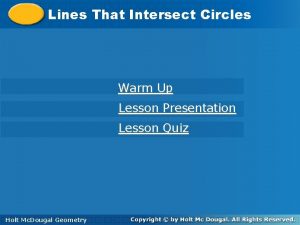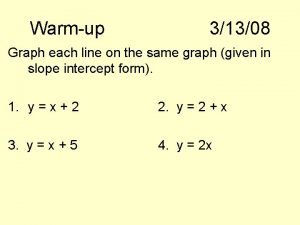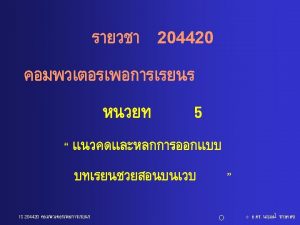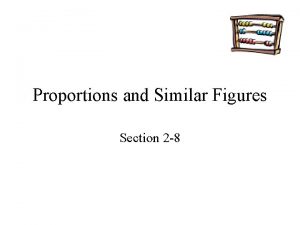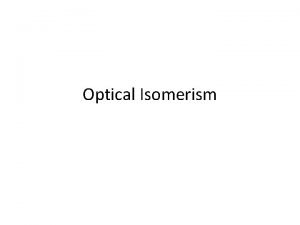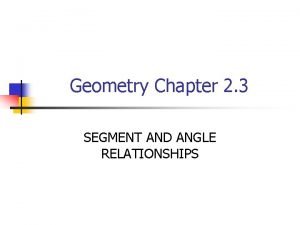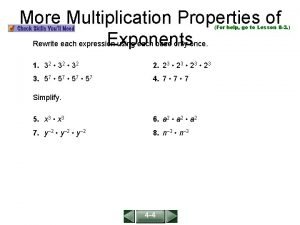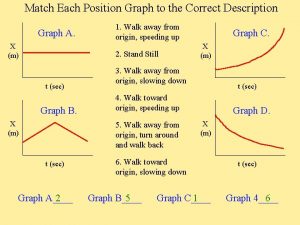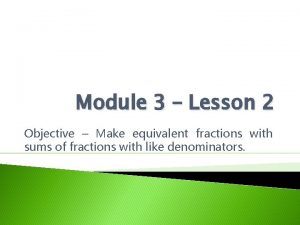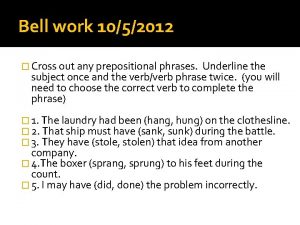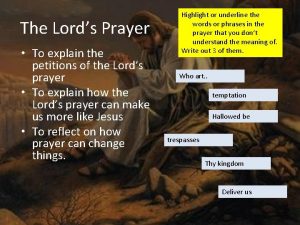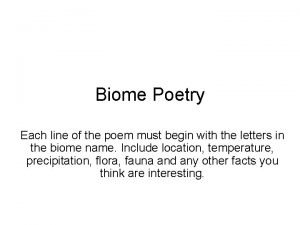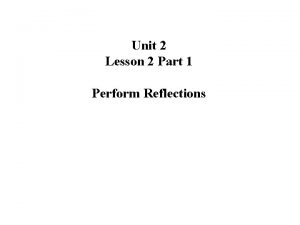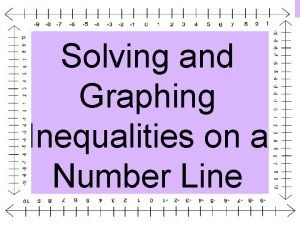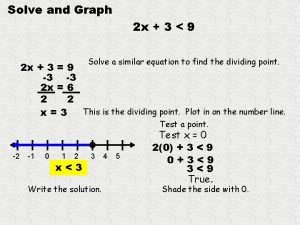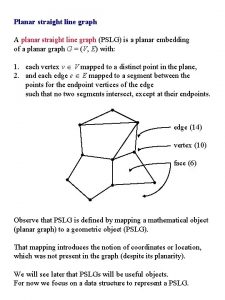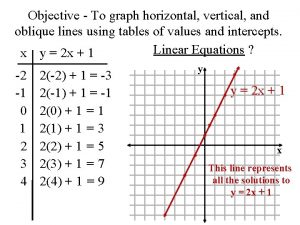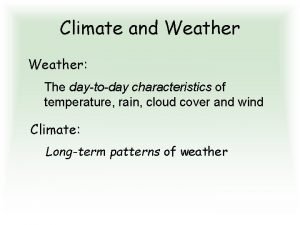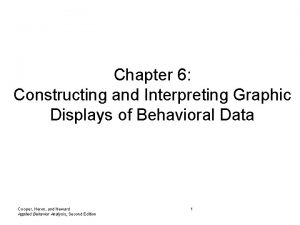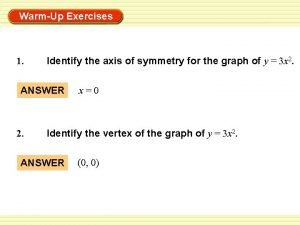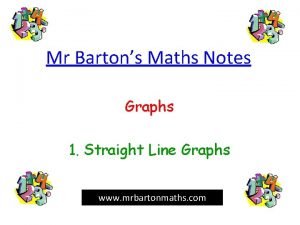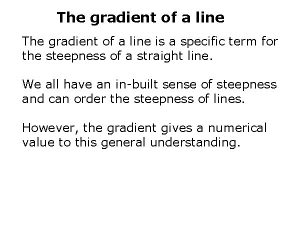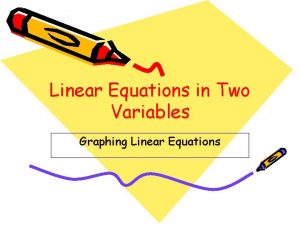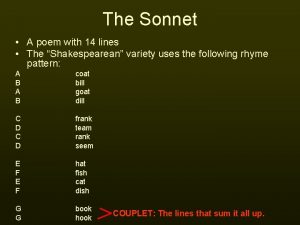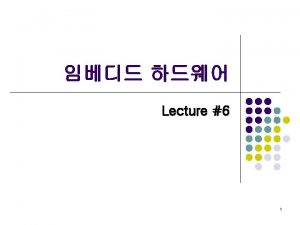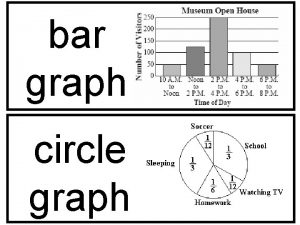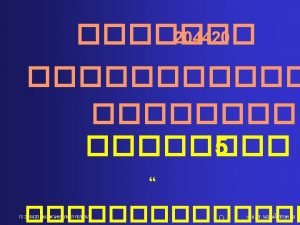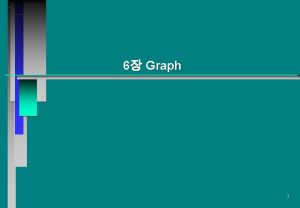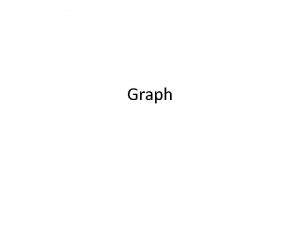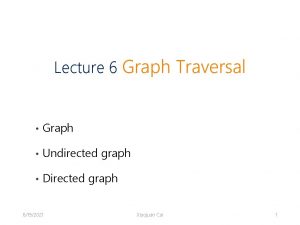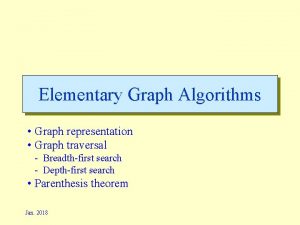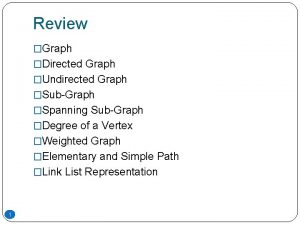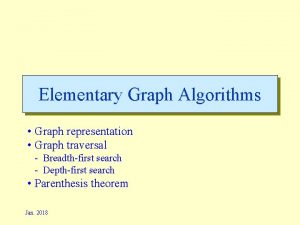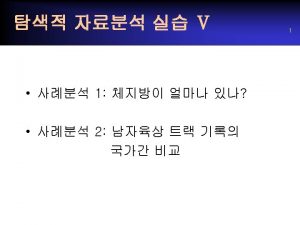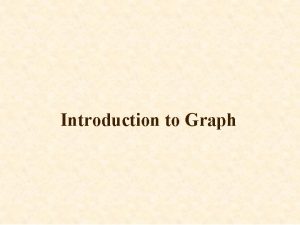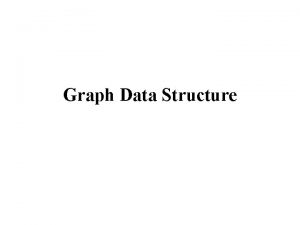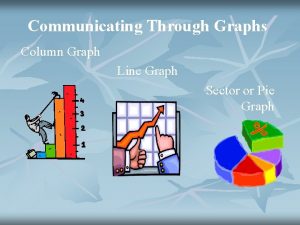Warmup 31308 Graph each line on the same





































































































- Slides: 101

Warm-up 3/13/08 Graph each line on the same graph (given in slope intercept form). 1. y = x + 2 2. y = 2 + x 3. y = x + 5 4. y = 2 x

Topic: Graphing Systems of Equations Key Learning(s): Solving systems of equations and inequalities by graphing, substitution, elimination, etc. Unit Essential Question (UEQ): Why would you need a system of equations?

Concept I: Graphing Systems of Equations Lesson Essential Question: 1) What are three different situations that can occur when graphing systems of linear equations? Vocabulary: Systems of linear equations No solution (parallel) Infinitely many solutions (collinear) One solution (Consistent)

Concept II: Solving Systems by Substitution Lesson Essential Question (LEQ): How do you solve a system of equations using substitution? Vocabulary:

Concept III: Solving Systems by Elimination Lesson Essential Question (LEQ): 1) How do you solve a system of equations using elimination? Vocabulary:

Concept IV: Solving Linear Inequalities Lesson Essential Question (LEQ): 1) How do graphing two variable inequalities compare with graphing to variable equations? Vocabulary:

Concept V: Solving Systems of Linear Inequalities Lesson Essential Question (LEQ): 1) How would you describe the process for solving a system of linear inequalities? Vocabulary:

Chapter 6 Introduction Guess and Test p. 268 #1 – 5

§ 6. 1: Linear Systems Solving by Graphing EQ: How can you use graphing to solve a system of equations? Two linear equations considered at the same time (system of equations) Types of graphs for two lines: Parallel Intersecting Collinear

Graph the two equations and find where they cross y = 2 x – 3 y=x– 1 Where do they cross? Once you find a point that you THINK is the solution, plug it into both equations to check it’s veracity. (2, 1)

Critical Thinking Do you think two lines always have exactly one solution? Draw some examples to support your answer.

Summary of properties of two equations in slope intercept form. Y-intercepts Slopes Graphs Same Collinear Different Same or different Different # of solutions Infinite Distinct None (they parallel lines never touch) Intersecting Exactly one lines

Two lines on the same graph can be: 1. Parallel – lines never intersect and have no ordered pairs in common 2. Intersecting – two lines cross at one point and have a specific ordered pair in common. 3. Collinear – two lines are actually the “same” line. They have all of their points in common.

Ex. These are 1 day car rental plans offered by the same company. Plan 1: $30 per day w/ unlimited mileage. Plan 2: $20 per day plus $0. 10 per mile. Make linear equations to model each plan. 1. y = 30 2. y = 20 + 0. 10 m Graph the two lines. At what point is the cost the same for both plans?

Rental Car Plans Break-even Point – the point where the two graphs intersect. What the intersection means. -Both plans cost the same if you drive exactly 100 miles. -Plan 1 is less expensive if you drive over 100 miles. -Plan 2 is less expensive if you drive under 100 miles.

Solving systems of equations To find the solution to a system of equations, you have to find all the ordered pairs that solve both equations. (where the two lines intersect) X Y y = 3 x – 5 & y = -x + 7 -1 -8 -1 8 0 -5 0 7 What ordered pair is 1 -2 1 6 the same for both 2 1 2 5 tables? 3 4 (3, 4) is the “solution” 4 7 4 3

Graphing Calculators! To graph two equations on the calculator (you can still do it by hand) 1. Y = 2. Put the equations in (the must be in slope intercept form!) 3. GRAPH 4. You should try to notice where they cross 5. 2 nd Graph (TABLE) to find the exact point. 6. The x-point where they y’s match is the answer. 7. Two check your answer you can plug in #’s.

§ 6. 1: Solving Systems of Equations by Graphing What kind of solutions do you get when lines are parallel or collinear? How many “solutions” do they have? Intersecting lines: One Parallel Lines: None Collinear lines (coinciding): Infinite

New Vocabulary Consistent – A system that has at least one solution. Independent – A system that has only one solution. Are intersecting lines consistent? Independent? Are parallel lines consistent? Independent? Are collinear lines consistent? Independent?

Recall: Parallel Lines – Two lines are parallel if they have the same slope. Vertical lines are parallel even though the slope is undefined. Inconsistent – A system with no solution. A parallel system is inconsistent. Dependent – A system that has infinite solutions.

Descriptions of the three types of systems: Intersecting Lines – Consistent and Independent Parallel Lines – Inconsistent Collinear Lines – Consistent and Dependent

On a Graphing Calculator: Determine if the lines are intersecting, collinear, or parallel. 1. Y = -2 – 4 x Y = (-4 – 8 x)/2 2. Y = 5 – x Y=4–x 3. Y = 5 – x Y = -3 + x

Word Problem Ex. The band director must order 35 uniforms. There are usually five more boys than twice the number of girls in the band. How many of each type of uniform should the director order? Set up a “system” with 2 equations. B = boys uniforms G = girls uniforms B + G = 35 B = 2 G + 5

Practice Graph each and find the “solution”. 1. y = x – 3 y = -2 x + 3 2. Y = 4 x – 5 y = -x + 7

Summary 1. How can you use the graphs of two equations to find the solution to a system of equations? 2. In what form must you write an equation to enter it tin a graphing calculator? 3. If two straight lines intersect on a graph, how many points of intersection are there?

Assignment Section 6. 1 p. 242 – 273 1, 3, 7 – 12 all, 13 – 23 odd, 25 – 28 all, 29, 31, 34, 35

Warm-up 3/15/08 Tell whether the lines are collinear, parallel, or intersecting. 1) x – y = -1 2) x – 2 y = 4 -x + y = -1 -x + 2 y = 6 Find the solution for the system of equations. 3) x + 2 y = 8 4) x – y = - 5 2 x – 3 y = 2 x+y=1

Heads Up! • Today is the last day for any make ups in the first 9 weeks • If you “borrowed” any calculators, please return them; I will be checking all of them by their serial numbers this afternoon, if you checked one out and it’s missing, you’ll be fined for it. • Book Check

So far, we’ve solved systems of linear equations using graphing, but don’t you wish there was an easier way? Solving by “algebra” …

§ 6. 2: Solving by Substitution EQ: What steps do you take to solve a system by substitution? Car Rental Problem: Plan 1: y = 30 Plan 2: y = 0. 10 x + 20 For the substitution method, you literally substitute one equation into the other one and solve using algebra (T-bar).

Steps: To solve a system by substitution: 1) Choose an equation and solve for x or y. 2) Substitute that expression into the other equation and solve. 3) Substitute the value found in step 2 back into the equation solved in step one.

Ex. y = 30 y = 0. 10 x + 20 1) Step is already done for the 1 st equation. 2) Substitute 30 for y in the other equation. 30 = 0. 10 x + 20 - 20 10 = 0. 10 x 0. 10 x = 100, y = 30 (constant)

Solve by Substitution. 3 x – y = 1 2 x + y = 9 1) 3 x – y = 1 y = 3 x – 1 2) 2 x + (3 x – 1) = 9 5 x – 1 = 9 + 1 +1 5 x = 10 5 5 x=2

3) Take x = 2 and put it back into the first equation to find what y is. y = 3(2) – 1 y=5 So the solution is (2, 5) You should always check your answers by 1) Putting the point back into both equations 2) Use a graphing calculator to check

Special Systems Solve by substitution. -2 x + y = -1 -6 x + 3 y = 12 1) Y = -1 + 2 x 2) -6 x + 3(-1 + 2 x) = 12 -6 x – 3 + 6 x = 12 -3 = 12 ? ? ? This system is inconsistent (parallel)

Solve by substitution. 4 x + y = -2 8 x + 2 y = -4 1) Y = -2 – 4 x 2) 8 x + 2(-2 – 4 x) = -4 8 x – 4 – 8 x = -4 -4 = -4 ? ? ? This system is dependent (collinear)

MORE EXAMPLES?

Solve using substitution X = 3. 2 -. 8 y Y = -1 (4, -1)

Solve using substitution X = 2/3 y + 4/3 Y = 3/2 x + 1 No solution

Solve using substitution X = -1/2 y + 2 Y = -2 x + 4 Infinitely many solutions

Solve using substitution X = 4 y – 4 Y = -1/2 x – 2 (-4, 0)

Summary 1) Describe the steps for solving a system of equations by substitution. 2) If a system of equations is inconsistent, what happens when you solve by substitution? 3) If a system is consistent and dependent, what happens when you solve the system by substitution? 4) Describe the advantages of using substitution to solve a system (instead of graphing).

Assignment Section 6. 2 p. 278 -279 #1 – 10 all, 38, 39 Turn in for a grade Homework p. 278 #11 – 21 odd

Warm-up 4/12/07 Re-write each equation in standard form. (So that x and y are on the same side. ) 1. Y = -2 x + 2 2. 2 x – 2 = y 3. -x + 3 = y 4. Y = x + 1 5. 4 x – 2 = y 6. Y = 3 x - 3

Assignment Section 6. 2 p. 278 -279 #1 – 10 all, 38, 39 Turn in for a grade Homework p. 278 #11 – 21 odd

§ 6. 3: Solving by Elimination EQ: Why should two equations be written in standard form before they are solved? Refresh: http: //www. algebra. com/algebra/homework/coo rdinate/lessons/Solving-Systems-of. Equations-1. lesson

In the elimination method, the goal is to “eliminate” one of the variables by subtraction so that you can solve a problem with one variable. To use elimination, the equations must be in standard form.

Ex. Nancy and Jim are team leaders at the Allied Computer Chip Manufacturing Company. The production supervisor needs to report the number of computer chips each team made on Friday. The total made by both teams is 130. Nancy’s team made 10 more chips than Jim’s team. x = Nancy’s Team y = Jim’s Team x + y = 130 x = y + 10 x - y = 10

Now you can line them up and solve by elimination. x + y = 130 x – y = 10 2 x = 140 Now solve like a regular equation. 2 x = 140 2 2 x = 70, Now find “y” by substituting into either one of the original equations (step 3).

x = y + 10 70=y +10 - 10 60 = y So, the final answer, as a point, is (70, 60). This is a word problem though, so you need to put it in “words”. Nancy’s team made 70. Jim’s team made 60.

Solve using elimination. x + y = 100 x – y = 30 x = 65 y = 35 Answer is (65, 35)

Solve using elimination. 2 x + 2 y = 10 3 x + 2 y = 14 -1 x = -4 Now solve like a regular equation. -1 x = -4 -1 -1 x=4 You have to substitute back into either original equation to solve for y.

2 x + 2 y = 10 2(4) + 2 y = 10 8 + 2 y = 10 -8 - 8 2 y = 2 y=1 So the final answer is (4, 1).

TWO GRAPHIC ORGANIZERS

Ticket – Out – The - Door 1) When is the addition method the best method for solving a system of equations in standard form? 2) When is the subtraction method best? 3) How do you write an equation in standard form? 4) Why should two equations be written in standard form before a system is solved?

§ 8. 5: Solving by Multiplication EQ: How can you use multiplication to solve a system of equations? Sometimes elimination does not seem possible. When this occurs, you can multiply an entire equation to make it “eliminate. ”

From the warm-up If question 4 was written in standard form: 2 x + 8 y = 20 x + 5 y = 12 Nothing cancels out, but you can “make it” eliminate by multiplying…

2 x + 8 y = 20 x + 5 y = 12 Multiply the whole 2 nd equation by 2 to “eliminate” x’s. 2(x + 5 y = 12) 2 x + 10 y = 24 2 x + 8 y = 20 -(2 x + 10 y = 24) -2 y = -4 y=2 Plug back in to get x: 2 (2, 2)

Ex 1. Solve this system. 2 x – 4 y = - 5 4 x + 3 y = 12 You could solve this equation by substitution, but it is more involved. If the top one was multiplied by 2, it would cancel out.

2(2 x – 4 y = -5) 4 x – 8 y = -10 -(4 x + 3 y = 12) Now solve by subtracting: -11 y = - 22 -11 y=2 Plug back in to get x: 4 x + 3 y = 12 4 x + 3(2) = 12 4 x + 6 = 12 4 x = 6 x = 1. 5; y = 2

Ex 2: Solve 3 x – 4 y = - 9 x – 3 y = 7 3 x – 9 y = 21 Now solve by subtracting: 3 x – 4 y = - 9 - (3 x – 9 y = 21) 5 y = -30 5 5 y = -6 Substitute back in: x – 3(-6) = 7 x = -11

Sometimes you have to multiply both equations to eliminate: Ex 3. 8 x + 5 y = 3 7 x + 3 y = -7 I choose to eliminate the y and the LCM is 15, so I get both to 15 by: 3(8 x + 5 y = 3) 5(7 x + 3 y = -7) 24 x + 15 y = 9 35 + 15 y = -35 Now, solve the system by subtracting.

24 x + 15 y = 9 - (35 + 15 y = -35) -11 x = 44 -11 x=-4 8(-4) + 5 y = 3 -32 + 5 y = 35 y=7 Final answer is (-4, 7)

Ex 4: Solve 4 x + 3 y + 6 = 0 3 x – 2 y – 4 = 0 First, put them in standard form. 4 x + 3 y = -6 3 x – 2 y = 4 I choose to eliminate x, so I multiply: 3(4 x + 3 y = - 6) 4(3 x – 2 y = 4)

12 x + 9 y = - 18 - (12 x – 8 y = 16) 17 y = -34 17 17 y = -2 Substitute back in to get x: 4 x + 3(-2) = - 6 4 x – 6 = - 6 4 x = 0 x=0 Final answer: (0, -2)

Warm-up 3/18/08 Solve each system of equations by any method you choose. 1) x + 2 y = 8 2) x – y = 8 2 x – 3 y = 2 x+y=1 3) x – y = 4 x+y=2 4) 2 x + 8 y = 20 5 y = 12 - x

Go over homework Group Quiz

Warm-up Solve each system using elimination. 1) 2 a – 3 b = 6 4 a + 3 b = 6 2) i – 3 j = 2 -2 i + 6 j = 4 3) -4 x + 3 y = 7 4 x + 6 y = 2 3/19/08 1) (2, -2/3) 2) No solution (parallel) 3) (-1, 1)

WORD PROBLEMS

Larger and Smaller Numbers The larger of two numbers is 354 more than the first number. The sum of the two numbers is 618. Find the two numbers. L = Larger number L = N + 354 L + N = 618 N = smaller number

http: //www. algebra. com/tutors/lessons-bytutor. mpl? tutor=nutshellmath

Practice In Notes: Section 6. 4 p. 287 -288 Selected Evens Assignment p. 287 -288 Selected Odds

§ 6. 5: Two Variable Inequalities EQ: How does graphing 2 -variable inequalities compare to graphing 2 -variable equations? Linear Inequality – Region of the coordinate plane bounded by a line.

Parts of an Inequality Graph • Values must satisfy the inequality (as before) • A dashed boundary line shows that the line is not part of the solution (< or >) • A solid boundary line shows that the line is part of the solution (≥ or ≤) • You must choose at lease one “test point” to determine which side of the line is the solution. (Method: guess and check)

Graph each inequality: 1) 4 x + 2 y ≤ 4 2) Y ≥ 3 x 3) x/3 < -y + 2 Ways to graph inequalities: -put into “slope-intercept form” to graph -find the x- and y-intercepts to graph

Graphing Absolute Value Inequalities *Remember in general to “sketch” graphs: - #’s outside move up and down - #’s inside move left and right (opposite) Graph the following inequalities: 1) Y = I 2 x + 4 I – 3 2) Y = 3 – Ix/2 I

Write an equation for the graph. The equation of the boundary line is given.

Write an equation for the graph. The equation of the boundary line is given.

Write an equation for the graph. The equation of the boundary line is given.

Write an equation for the graph. The equation of the boundary line is given.

Write an equation for the graph. The equation of the boundary line is given.

Write an equation for the graph. The equation of the boundary line is given.

Write an equation for the graph. The equation of the boundary line is given.

Write an equation for the graph. The equation of the boundary line is given.

Graph this:

Graph this:

Graph this:

Graph this:

Graph this:

Graph this:

Graph this:

Graph this:

Graph this:

Graph this:


Warm-up 3/21/08 Solve each system of equations or inequalities. Also, tell whether the graphs will be collinear, parallel, or intersecting. *Solve a system of inequalities the same, then shade the “overlapping” shaded area for the answer. 1) y = 4 x + 1 2) x + y > 5 3) 5 y = 3 x – 7 y = 4 x – 3 x – y < -1 4 x – 3 y = -7 4) y – 4 = x 5) 2 y – 3 x = 6 2 x + 8 = 2 y 4 y = 6 x + 8 6) 2 x – 3 y = 2 y–x=-1

Collect Wrap – ups (Ashley) Warm-ups (Brittany) Papers (Cory)

Test Questions? • Solving by graphing • Solving by substitution • Solving by elimination • Graphing an inequality • Graphing systems of inequalities


Warm-up 4/17/07 Solve the following equations using any method. Determine if they are collinear, intersecting, or parallel. 1) 4 x + y = -2 8 x + 2 y = -4 2) 3 x – y = 1 2 x + y = 9

Warm-up 4/10/07 Solve each of the equations for y. 1. 2. 3. 4. 5. 6. 2 x + y = 9 x+y=4 5 x – 2 y = 18 x + 2 y = -6 4 x + 2 y = -2 3 x + y = -2 1. 2. 3. 4. 5. 6. y = 9 – 2 x y=4–x y = (18 – 5 x)/-2 y = (-6 – x)/2 y = (-2 – 4 x)/2 y = -2 – 3 x
 Identify each line or segment that intersects each circle
Identify each line or segment that intersects each circle Graph each line
Graph each line Warmup ratio
Warmup ratio Warmup 65
Warmup 65 Gmass warmup
Gmass warmup Stratified warmup
Stratified warmup Surface area warm up
Surface area warm up Monorhyme
Monorhyme Multiplying exponents with same base
Multiplying exponents with same base Java warmup
Java warmup Define:warmup
Define:warmup Pathos story
Pathos story Tinman warm up
Tinman warm up 65 mins
65 mins Warmup end
Warmup end Line graph graph theory
Line graph graph theory Same time same place แปลว่า
Same time same place แปลว่า Same place same passion
Same place same passion Similar
Similar 2-8 proportions and similar figures
2-8 proportions and similar figures Same same
Same same Check line tie line base line
Check line tie line base line Midpoint formula
Midpoint formula More multiplication properties of exponents
More multiplication properties of exponents Match each graph with the correct description
Match each graph with the correct description Hát kết hợp bộ gõ cơ thể
Hát kết hợp bộ gõ cơ thể Bổ thể
Bổ thể Tỉ lệ cơ thể trẻ em
Tỉ lệ cơ thể trẻ em Gấu đi như thế nào
Gấu đi như thế nào Tư thế worms-breton
Tư thế worms-breton Chúa yêu trần thế alleluia
Chúa yêu trần thế alleluia Các môn thể thao bắt đầu bằng tiếng đua
Các môn thể thao bắt đầu bằng tiếng đua Thế nào là hệ số cao nhất
Thế nào là hệ số cao nhất Các châu lục và đại dương trên thế giới
Các châu lục và đại dương trên thế giới Công thức tính độ biến thiên đông lượng
Công thức tính độ biến thiên đông lượng Trời xanh đây là của chúng ta thể thơ
Trời xanh đây là của chúng ta thể thơ Mật thư tọa độ 5x5
Mật thư tọa độ 5x5 Phép trừ bù
Phép trừ bù độ dài liên kết
độ dài liên kết Các châu lục và đại dương trên thế giới
Các châu lục và đại dương trên thế giới Thể thơ truyền thống
Thể thơ truyền thống Quá trình desamine hóa có thể tạo ra
Quá trình desamine hóa có thể tạo ra Một số thể thơ truyền thống
Một số thể thơ truyền thống Cái miệng nó xinh thế
Cái miệng nó xinh thế Vẽ hình chiếu vuông góc của vật thể sau
Vẽ hình chiếu vuông góc của vật thể sau Thế nào là sự mỏi cơ
Thế nào là sự mỏi cơ đặc điểm cơ thể của người tối cổ
đặc điểm cơ thể của người tối cổ Ví dụ giọng cùng tên
Ví dụ giọng cùng tên Vẽ hình chiếu đứng bằng cạnh của vật thể
Vẽ hình chiếu đứng bằng cạnh của vật thể Fecboak
Fecboak Thẻ vin
Thẻ vin đại từ thay thế
đại từ thay thế điện thế nghỉ
điện thế nghỉ Tư thế ngồi viết
Tư thế ngồi viết Diễn thế sinh thái là
Diễn thế sinh thái là Dạng đột biến một nhiễm là
Dạng đột biến một nhiễm là Các số nguyên tố
Các số nguyên tố Tư thế ngồi viết
Tư thế ngồi viết Lời thề hippocrates
Lời thề hippocrates Thiếu nhi thế giới liên hoan
Thiếu nhi thế giới liên hoan ưu thế lai là gì
ưu thế lai là gì Hổ sinh sản vào mùa nào
Hổ sinh sản vào mùa nào Sự nuôi và dạy con của hươu
Sự nuôi và dạy con của hươu Sơ đồ cơ thể người
Sơ đồ cơ thể người Từ ngữ thể hiện lòng nhân hậu
Từ ngữ thể hiện lòng nhân hậu Thế nào là mạng điện lắp đặt kiểu nổi
Thế nào là mạng điện lắp đặt kiểu nổi Wait-for graph
Wait-for graph Natalie sawed five boards of equal length to make a stool
Natalie sawed five boards of equal length to make a stool Find out the odd word from the group
Find out the odd word from the group Choose the best paraphrase for each line in this quatrain
Choose the best paraphrase for each line in this quatrain Cross out the prepositional phrase
Cross out the prepositional phrase The petitions of the lord's prayer
The petitions of the lord's prayer Tundra acrostic poem
Tundra acrostic poem Lesson 2 reflections
Lesson 2 reflections Graphing solutions on a number line
Graphing solutions on a number line Solve
Solve Planar straight line graph
Planar straight line graph Oblique line graph
Oblique line graph Climatograph of taiga
Climatograph of taiga Make a bar graph
Make a bar graph Scale break aba
Scale break aba 5-5 linear automobile depreciation answers
5-5 linear automobile depreciation answers Pie chart terminology
Pie chart terminology Which graph shows line symmetry about the y-axis?
Which graph shows line symmetry about the y-axis? Mr barton maths
Mr barton maths Negative slope graph
Negative slope graph Flow chart display
Flow chart display Bar graph mean median mode
Bar graph mean median mode Line of best fit graph
Line of best fit graph Vertical line on a graph
Vertical line on a graph Jul850
Jul850 Ulysses poem explanation
Ulysses poem explanation To daffodils by robert herrick poem analysis
To daffodils by robert herrick poem analysis Thou blind man's mark analysis
Thou blind man's mark analysis A sonnet has 14 lines
A sonnet has 14 lines Taj mahal rabindranath tagore
Taj mahal rabindranath tagore Sonnet 60 by william shakespeare summary
Sonnet 60 by william shakespeare summary Sonnet 130 as an unconventional love poem
Sonnet 130 as an unconventional love poem Sonnet 57 meaning
Sonnet 57 meaning Meaning of sonnet 130
Meaning of sonnet 130 Ram lines
Ram lines
